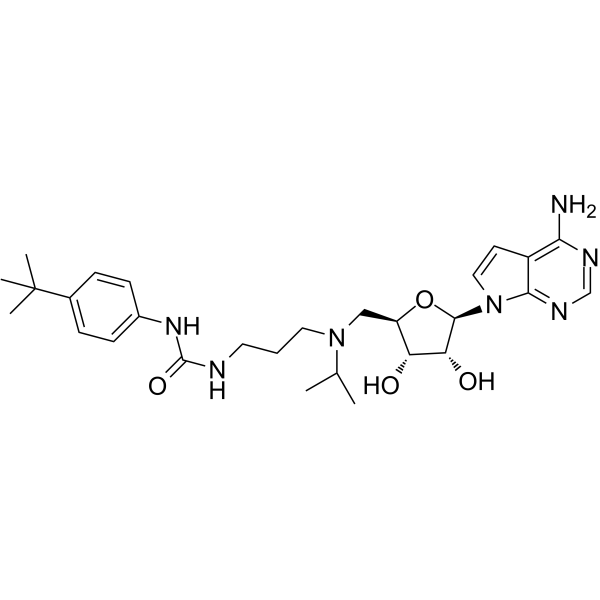Home
Products
EPZ004777



| Product Name | EPZ004777 |
| Price: | Inquiry |
| Catalog No.: | CN00280 |
| CAS No.: | 1338466-77-5 |
| Molecular Formula: | C28H41N7O4 |
| Molecular Weight: | 539.67 g/mol |
| Purity: | >=98% |
| Type of Compound: | Alkaloids |
| Physical Desc.: | Powder |
| Source: | |
| Solvent: | Chloroform, Dichloromethane, Ethyl Acetate, DMSO, Acetone, etc. |
| SMILES: | O=C(Nc1ccc(cc1)C(C)(C)C)NCCCN(C(C)C)C[C@H]1O[C@H]([C@@H]([C@@H]1O)O)n1ccc2c1ncnc2N |
| Contact us | |
|---|---|
| First Name: | |
| Last Name: | |
| E-mail: | |
| Question: | |
| Description | EPZ004777 is a potent, selective DOT1L inhibitor with an IC50 of 0.4 nM. |
| Target | IC50: 0.4 nM (DOT1L)[1] |
| In Vitro | EPZ004777 demonstrates potent, concentration-dependent inhibition of DOT1L enzyme activity with an IC50 of 400±100 pM. EPZ004777 displays remarkable selectivity for inhibition of DOT1L over other HMTs(PRMT5, 521±137 nM; others, >50 μM). The effect of extended EPZ004777 treatment is remarkably specific for the MLL-rearranged cell lines. The number of viable MV4-11 and MOLM-13 cells is dramatically reduced by EPZ004777, whereas the growth of Jurkat cells is unaffected. A small population of MV4-11 cells remain viable in the presence of EPZ004777, but their number remain constant when growth curves are tracked over longer periods indicating that they have ceased to divide. The proliferation of MLL-AF9-transformed cells is strongly inhibited by EPZ004777 at concentrations of 3 μM or greater[1]. EPZ004777 selectively inhibits proliferation of MLL-AF10 and CALM-AF10 transformed murine bone marrow cells[2]. |
| In Vivo | EPZ004777 is well tolerated and no overt toxicity is observed. Complete blood count analysis after 14 days of continuous exposure to EPZ004777 revealed a statistically significant increase in the total white blood cell count, which resulted from an increase in neutrophils, monocytes, and lymphocytes. EPZ004777 (50, 100, or 150 mg/mL) administration is well tolerated, and no significant weight loss is observed[1]. |
| Cell Assay | For assessment of cell proliferation and viability in human cell lines, exponentially growing cells are plated, in triplicate, in 96-well plates at a density of 3×104 cells/well in a final volume of 150 μL. Cells are incubated in the presence of 3 μM (proliferation curve), or increasing concentrations (IC50 determination) of EPZ004777 up to 50 μM. Viable cell number is determined every 3-4 days for up to 18 days using the Guava Viacount assay and analyzed on a Guava EasyCyte Plus instrument. On days of cell counts, growth media and EPZ004777 are replaced and cells split back to a density of 5×104 cells/well. Total cell number is expressed as split-adjusted viable cells per well. For each cell line, IC50 values are determined from concentration-dependence curves at each time point using Graphpad Prism software. Experiments to determine IC50 values continued until IC50 values stabilized (day 18 for THP-1 cells, day 14 for all other cell lines)[1]. |
| Animal Admin | Mice[1] Nine-week-old female nude mice (nu/nu) are injected subcutaneously with MV4-11 cells in the right flank (200 μL of a 5×107 cells/mL suspension in a 1:1 mixture of PBS and Matrigel). Mice are randomized to treatment groups when tumor sizes reached 300-400 mm3. Six mice received subcutaneous implant of osmotic pumps, containing 50 mg/mL EPZ004777 in 10% ethanol, 90% water, and five control mice received no pump implant. Six days after pump implant, animals are sacrificed and tumor samples from treated and control animals are collected for immunoblot analysis. For the disseminated leukemia model, MV4-11 cells are transduced with the pMMP-LucNeo retrovirus. Eight-week-old female NOD.Cg-PrkdcscidIl2rgtm1Wjl/SzJ (NSG) mice are purchased from Jackson Laboratories. A total of 1×107 MV4-11-LucNeo cells are injected intravenously via the lateral tail vein. Engraftment of disseminate leukemia is determined by bioluminescence imaging after injection of 75 mg/kg of D-luciferin. Animals with documented leukemia are divided into treatment groups consisting of vehicle (15% ethanol, 50% PEG300, 35% water) loaded osmotic pumps, or EPZ004777 at 50, 100, or 150 mg/mL. Osmotic pumps are replaced after one week. Irritation caused by compound precipitation is observed in the 100 and 150 mg/mL dose groups, precluding additional pump replacements. Animals are monitored daily for clinical symptoms, and are euthanized when they displayed signs of distress consistent with terminal leukemic disease. Log-rank analysis is used to determine statistical significance of the survival curves. |
| Density | 1.3±0.1 g/cm3 |
| Boiling Point | 740.7±60.0 °C at 760 mmHg |
| Flash Point | 401.7±32.9 °C |
| Exact Mass | 539.322021 |
| PSA | 154.28000 |
| LogP | 3.94 |
| Vapour Pressure | 0.0±2.6 mmHg at 25°C |
| Storage condition | -20℃ |